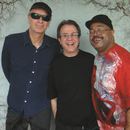Time to ease the seat back, slide into Niacin, and discover for yourself one of the lost arts of rock's rich history: the Hammond B-3 sound, or more panoramically, the hot and heavy boiler room magic that can erupt out of a classic keyboards, bass and drums three-piece.








Already starting with an arcane premise, the results could have been less than spectacular in the hands of lesser legends. But John Novello, Dennis Chambers and bass monster Billy Sheehan ain't lesser anything, having cut their teeth through collective decades of rock, fusion and purist jazz creativity, converging then exploding. Following in the rambunctious, irreverent and raucous tradition of "Niacin", "High Bias", "Live - Blood Sweat and Beers", "Deep" and "Time Crunch"; Niacin now unleash "Organik."
Billy Sheehan, spider-fingered bass acrobat for such bands as Talas, David Lee Roth and Mr. Big, lays down the overall vibe for the project. "We definitely went more towards some of our late '60s, early '70s prog rock roots, people like King Crimson, PFM, Gentle Giant, early Genesis and of course, Emerson, Lake & Palmer, a classic B-3 band, and one we often get compared to. Both John and I as writers have many, many influences. We've both gone in many directions in our years of playing. And a good part of that is that you have a big bag of tricks to pull from. So we have a lot of things that we can reference or use as inspiration."
Billy's bandmates are more than up to the task to help shape, create and develop the vision. "Dennis Chambers, man, I wouldn't know where to start to tell you what records he's been on. He's worked with Chick Corea, Steely Dan, Parliament/Funkadelic, even James Brown. He's just an absolute champion of the drums. His jazz and funk roots are as deep as the tallest oak is tall (laughs). And as a person, he is ego-free, completely selfless. It's an inspiration because he is just so possessed by playing music. That's all he does, tour and play music. And even if his background is jazz, he loves rock. In soundcheck we'll play Grand Funk, Zeppelin. He's not a jazz snob at all. He digs so many different kinds of music. And that's kind of inherent with all of us, so it works out really good when we play together."
Keyboardist John Novello is, in essence, the guitarist and lead vocalist of Niacin even if he accomplishes the entire ball of wax on his coterie of B-3 vocabularies. "Well, John is a real expert at the B-3 thing. And you know, it's fallen on keyboardists' shoulders to know the computer and MIDI stuff and he's become an expert at that too. But he can also remove himself from that whole computer thing and play real heart and soul type stuff, almost like gospel, on the B3. It's funny. There's this white guy, but you look over your shoulder, and you think you see a black choir behind you singing (laughs). It's really cool. And a big part of that is his groove. And just as a person, he's really fastidious, and he cares a lot about the overall sound of the band; he's more of a team player than an individualist. I like that a lot."
Niacin's B-3 sound harkens back to a great history within the rock tradition, something the band has front-and-center celebrated and revived. Billy charts some of the classic B-3 greats through history. "Well, there's some of the standards, like Jimmy Smith, Jimmy McGriff, Jack McDuff, the B-3 legends; Humble Pie and Spooky Tooth, Traffic or some of the Blind Faith stuff. Keith Emerson is the standard in the prog field, but there's B-3 all through Yes and even Led Zeppelin's debut which is a great B-3 record as is Hendrix's Electric Ladyland. Jon Lord (Deep Purple) and Ken Hensley (Uriah Heep) and some of the prog guys went for a rockier, grinding version of it. I believe Jon Lord put it through a Marshall. But the jazz guys like Jimmy Smith tended to go straight or through a clean Leslie cabinet."
Billy is quick to flesh out and clarify his definition of the B-3 sound. "B-3 is used to designate the basic Hammond sound. There are several other instruments that do it, like the A-100 and the M-3, but basically when you say B-3 you are talking about the Hammond sound. Purists will bristle if I don't say whether we're talking about B-3, M-3 or an A-100 but, in actual fact, it's pretty much the same mechanics that go into creating that sound in all the Hammond organs."
"It's a really distinguishable sound," Billy adds. "And, for a long time, I remember in the late '60s and the early '70s, if you didn't have a B-3, you were basically out of luck as a band. Everybody had to have one. It was an integral a part of music in that era as the Telecaster, Strat, Les Paul, Fender P bass or Ludwig drums."